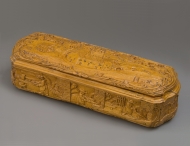Carved box for pipe tobacco
juillet 2019

A magnificent piece of carving is visible in this German tobacco box. It is made entirely of wood, including the seven-part hinge, a true piece of technical craftsmanship. Within a frame of Louis XV motifs, the box displays an interesting scene with an encyclopedic background. On the lid we see a landscape with a stone mill building in the center with a water wheel. The cartouche on the top explains the function and gives the date 1780. Shown is an iron crushing plant where a heavy hammer is driven by hydropower. The front of the box is the further explanation of the lid, because there we see what happens behind the facade of the factory building in four stages. The bottom of the box shows the extraction of the iron ore, with a simple hoist high on a mountain, and next to it is a castle. The box refers to the iron production in the town of Gimborn on the Leppe river in what will later become Ruhr region. From the 14th century onwards, iron ore was mined on a small scale in North Rhine-Westphalia and melted with wood from local forests. Water mills were responsible for driving the bellows and crushing hammers. The scene with the full production run of the iron on this tobacco box is an exceptionally rare document about the pre-industrial history of Germany. It is quite conceivable that the tobacco box was made for Fürst Schwarzenberg, the lord of the Gimborn castle.
Amsterdam Pipe Museum PM 22.939
Permalink